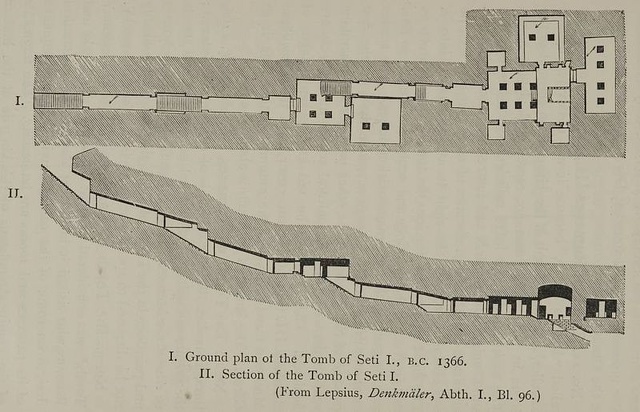Home | Category: Death and Mummies
VALLEY OF THE KINGS TOMBS
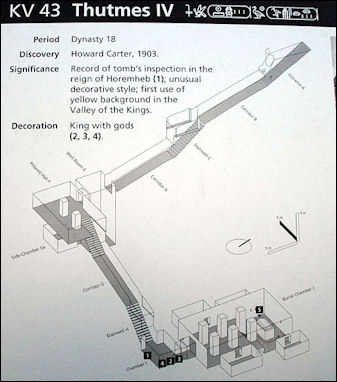
Tomb of Thutmose IV Valley of the Kings is the burial ground of the pharaohs of the New Kingdom, which ruled around 1500 B.C. to 1100 B.C. Known to the ancient Egyptians as “The Great and Majestic Necropolis,” the valley is surrounded by barren mountains, with largest being Al-Qurn (the Horn).
The tombs were once filled with unimaginable wealth, hinted at by the artifacts found in the tomb of King Tutankhamun (King Tut), who was a relatively minor king with a relatively modest tomb. The other tombs were all looted of their treasures millennia ago. The tomb of Ramses II, arguably the greatest pharaoh of all, probably contained one of the greatest treasure hordes, but we will probably never know what those treasures were: his tomb was looted only 150 years after his death. Altogether more than 60 tombs are located in the Valley of the Kings. Archeologists have identified the probable resting places of 41 royals in 37 tombs (some tombs held more than one body) but in some cases the identity of the pharaoh that a tomb honors is unknown.
The Valley of the Queens is where most of the wives and children of the important New Kingdom pharaohs were buried. The tombs are similar to the tombs in the Valley of Kings in that they are carved into the rock faces of the valley walls of limestone cliffs and arid, eroded mountains, and are composed of several rooms and corridors leading to the burials chambers. Only five of the more than 70 tombs are open to visitors. The Valley of the Queens is closer to the ticket office than the Valley of the Kings. It is still a considerable distance from Luxor.
See Separate Article: VALLEY OF THE KINGS: HISTORY, TOMBS, DISCOVERIES africame.factsanddetails.com
Website: Theban Mapping Project: www.thebanmappingproject.com
RECOMMENDED BOOKS:
“The Treasures of the Valley of the Kings: Tombs and Temples of the Theban West Bank in Luxor” by Kent Weeks and Araldo De Luca (2020) Amazon.com;
” Guide to the Valley of the Kings” by Alberto Siliotti, Ann Ghiringhelli, Patrizia Lovisetti (1997) Amazon.com;
“The Complete Valley of the Kings: Tombs and Treasures of Egypt's Greatest Pharaohs” (1996) by Nicholas Reeves and Richard Wilkinson Amazon.com;
“KV5: A Preliminary Report on the Excavation of the Tomb of the Sons of Ramesses II in the Valley of the Kings” by Kent R. Weeks (2001) Amazon.com;
“The Discovery of the Tomb of Seti I” by Giovanni Battista Belzoni (1778-1823) Amazon.com;
“King Tutankhamun: The Treasures of the Tomb” by Zahi Hawass (2007) Amazon.com;
“The Discovery of the Tomb of Tutankhamen” by Howard Carter (1923, 2012) Amazon.com;
“In the Valley of the Kings: Howard Carter and the Mystery of King Tutankhamun's Tomb” by Daniel Meyerson (2009) Amazon.com;
“Valley of the Kings Historical Map of Tombs of the Pharaohs” by Franko Maps Amazon.com;
“The Oxford Handbook of the Valley of the Kings” by Richard H. Wilkinson and Kent R. Weeks Amazon.com;
“The Tomb in Ancient Egypt” by Aidan Dodson, Salima Ikram (2008) Amazon.com;
“Death and Burial in Ancient Egypt” by Salima Ikram (2015) Amazon.com
”Burial Customs in Ancient Egypt: Life in Death for Rich and Poor”, Illustrated,
by Wolfram Grajetzki (2003) Amazon.com;
“Life and Death in Ancient Egypt: Scenes from Private Tombs in New Kingdom Thebes” by Sigrid Hodel-Hoenes (2000) Amazon.com;
“The Royal Tombs of Egypt: The Art of Thebes Revealed” by Zahi Hawass (2006) Amazon.com;
“The Lost Tombs of Thebes: Ancient Egypt: Life in Paradise” by Zahi Hawass and Sandro Vannini (2009) Amazon.com;
“Thebes in Egypt: A Guide to the Tombs and Temples of Ancient Luxor” by Nigel Strudwick (1999) Amazon.com;
Tombs of Famous Pharaohs in the Valley of the Kings
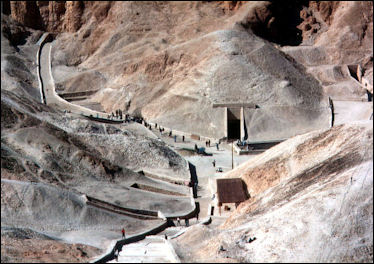 Tomb of Ramses IX is regarded the most beautiful, well-preserved and exquisitely crafted tomb in the Valleys of the Kings and Queens after the Tomb of Nefertari. It has an interesting depiction a pharaoh’s journey to the underworld. The Tomb of Ramses VI is regarded as almost as beautiful as the Tomb of Ramses IX. The Tomb of Ramses VI opened in the late 1990s after being closed for 40 years and undergoing restoration. Dated to the 12th century B.C., it contains well-preserved wall paintings depicting Egyptian history and a ceiling decorated with constellations. It also has some grafit from the Greco-Roman period.
Tomb of Ramses IX is regarded the most beautiful, well-preserved and exquisitely crafted tomb in the Valleys of the Kings and Queens after the Tomb of Nefertari. It has an interesting depiction a pharaoh’s journey to the underworld. The Tomb of Ramses VI is regarded as almost as beautiful as the Tomb of Ramses IX. The Tomb of Ramses VI opened in the late 1990s after being closed for 40 years and undergoing restoration. Dated to the 12th century B.C., it contains well-preserved wall paintings depicting Egyptian history and a ceiling decorated with constellations. It also has some grafit from the Greco-Roman period.
Tomb of Tutmosis III is one of the most-visited tombs in the Valley of the Kings by visitors with a three-tomb ticket. Reached by series of metal ladders, it is perched high in the valley about 400 meters from the other tombs. The Tomb of Seti I is the largest and most decorated tomb. The Tomb of Amenhotep II some say is the most beautiful tomb in the Valley of the Kings.
Tomb of Amenhotep II contained side chamber where the mummies of Ramses IV, V and VI were found. In another chamber the mummy of a boy, young woman and older woman were found. The remains of the young woman had been badly mutilated. Some think the mutilated young woman may have been Nefertiti.
Ramsesseum (near Tombs of Nobles) is the mortuary temple of Ramses II. Built as an expression to his greatness, it has been desecrated and was scavenged for materials over the years and now lies mostly in ruins. It features painting of the pharaoh depicted as Osiris, the god of the afterlife, and murals of the Battle of Kadesh. The head of the multi-ton, 57-foot-high colossi of Ramses II that inspired the Shelley poem “Ozymandias” and guarded the temple were hauled away in 1817 by the Italian adventurer Giovanni Belzoni. He hired scores of Egyptians to drag the seven-ton heads to a boat that carried the heads up the Nile and eventually to London. The bust and other Belzoni "conquests" now form the core of the Egyptian collection at the British museum.
King Tutankhamen's Tomb
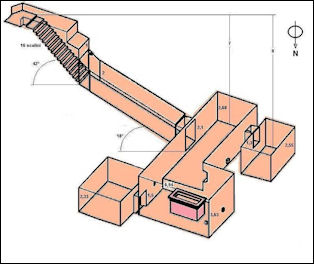
Tutankhamen's tomb King Tutankhamen's Tomb (Valley of the Kings) is one of the most visited tombs in the Valley of the Kings and has a separate admission price. Its discovery in 1922 was one of the greatest archeological discoveries of all time. Tutankhamen was only a minor king — he didn't build a pyramid or any great temples or monuments and he died before he was 21 — but it just so happens that his tomb was one of the few in the Valley of the Kings with a treasure missed by looters.
King Tutankhamun Tomb is located 26 feet underground. It was constructed from the relatively small unfinished tomb of courtier after the king died at an early age. Objects for the afterlife were crammed in the tomb and the paintings were so hastily prepared that splashes of paint that cover some of the images was not cleaned up. Some of the burial objects appear to have belonged to others (their names were erased and replaced with King Tutankhamun’s name).
Tutankhamen was well prepared for his trip to the afterlife. His four-room tomb yielded gold treasures; gilt coffins with images of the king emblazoned on the them; a glittering throne with palace scenes; effigies of gods and goddesses; a chest inscribed battles scenes; and jeweled daggers, earrings, necklaces and other riches. The most famous object found in it was Tutankhamun’s blue and gold funerary mask, which has been pictured in many books and magazines. All of these things are in the Egyptian museum, except when they are on tour.
Some painting in the tomb depict Tutankhamun funeral procession. After the funeral procession, his successor, Aye, symbolically revives the dead. Nut, the sky goddess welcomes Tutankhamun to the realm of the gods, and Osiris, god of the afterlife, embraces him along with his “ka” , or spiritual double. Baboons on the far wall represent the start of his passage through 12 hours of the night.
See Separate Articles: TUTANKHAMUN’S TOMB: CONTENTS, ITEMS, TREASURES africame.factsanddetails.com ; DISCOVERY OF THE TOMB OF KING TUTANKHAMUN (KING TUT) africame.factsanddetails.com
Tomb of Nefertari
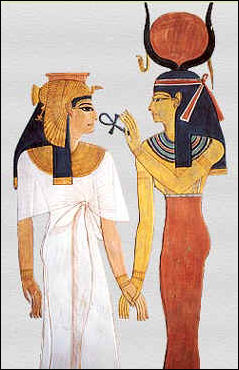
Nefertari tomb painting The Tomb of Nefertari (in the Valley of the Queens near Luxor) is the most beautiful tomb in the Valley of the Queens or the Valley of the Kings and one of the most extraordinary works of art in the world. Over 3,200 year old, it is in amazingly good condition for its age and features extraordinary wall murals, painted with vivid colors, great skill and a wonderful sensitivity for detail.
Regarded as a close representation of the "House of Eternity," the tomb of Queen Nefertari is composed of seven chambers—a hall, side chambers and rooms connected by a staircase—and features paintings made on engraved outlines of humans, deities, animals, magic objects, scenes of everyday life and symbols such as ibis heads, scarabs, papyrus, lotuses, vultures and cobras.
The top chambers show Nefertari preparing for her journey to the afterlife. The stairway downward from the upper chamber represents the journey itself. The bottom level contains the actual burial chamber. Here Nefertari is depicted being accepted into the afterlife world ruled by Osiris.
On being inside the tomb, Marlise Simons wrote in the New York Times,"The effect is rich like a house hung with jewelry, and it has an intensity that appeals strongly to modern eyes. But what makes these galleries just as moving is the fine detail of the images, their exquisitely carved relief and the gestures of endearment that give the figures life...There is are sweetness and intimacy that makes contact across the centuries seem somehow possible."
See Separate Article: TOMB OF NEFERTARI: CHAMBERS, PAINTINGS, MEANING OF THE ART africame.factsanddetails.com
Tomb of Seti I
The Tomb of Seti I is the largest and most decorated tomb in the Valley of the Kings. Known to scholars as KV17, its is extends 88 meters (290 feet) from entrance hall to burial chamber and goes on 173 meters (570 feet) further in what may be an attempt to construct a tunnel to the underworld. Ritual features in the tomb include a well chamber, and scenes from Egyptian funerary texts. One of these, from the Book of Gates, depicts the journey of a soul through the underworld.[Source: José Lull, National Geographic History, June 26, 2020]
José Lull wrote in National Geographic History: Not only are the tomb’s artworks breathtaking to see, they also provided today’s Egyptologists with the earliest, most complete set of funerary texts from ancient Egypt. Wall paintings depict detailed scenes from the Book of Amduat and texts from the Litany of Re, a collection of invocations and prayers to the solar deity. The giant sarcophagus is decorated with scenes from the Book of Gates — an Egyptian text that recounts the passage of a soul through the underworld — and is today regarded as one of the most important artifacts from Egypt’s 19th dynasty.
Extensive conservation efforts are being carries out to protect and preserve Seti’s tomb. In 2016 the Factum Foundation used the latest technology to scan and photograph the entire complex not only to preserve and study its artworks, but also to create high-precision facsimiles that can be printed to erect full-size models of the tomb in full color. Visitors can experience the majesty of a pharaoh’s resting place without endangering the original. The excavation of the tomb is largely complete, but its aura of enigma will linger, it seems, for centuries to come.
Entrance and the First Rooms of Seti I’s Tomb
José Lull wrote in National Geographic History: The entrance to Seti’s tomb leads to a series of preliminary corridors and chambers. The walls in these opening chambers are covered with myriad artworks (in the form of colored reliefs) depicting funerary texts centering on the sun god Re. One of these is the New Kingdom Book of Amduat, showing the journey taken each night by Re. Over the course of 12 hours, he must overcome obstacles using the magical texts shown on the walls. The walls also feature texts from the Litany of Re, a collection of invocations and prayers to the solar deity. Visitors descend a set of stairs and then proceed through three corridors. [Source: José Lull, National Geographic History, June 26, 2020]
In the first room, Seti I can be seen greeting the god Re-Horakhty in a scene from the Litany of Re, which associates the deceased pharaoh with the various forms of the sun god. A succession of vultures representing the goddess Nekhbet appear on the ceiling against a starry background. Images from the Litany also appear in the second stairway and depict Re in different forms. The next corridor depicts different stages of Re’s nightly journey on the left and right walls, as recounted in the Book of Amduat. A visitor’s journey then pauses at the well chamber, which symbolizes the burial of Osiris, god of the underworld. Artworks here show gods welcoming the deceased pharaoh.
After the Well of Osiris, visitors pass into a room supported by four richly adorned pillars. Whereas the preliminary corridors and chambers centered on the role of the solar god Re, this space marks a shift in tone to a type of art that historians term “chthonic” (related to the underworld). The artwork in this room depicts scenes from the Book of Gates, a funerary text that recounts the deceased’s journey through the underworld, in which each hour of the night is marked by a heavily guarded gate. Although the Book of Gates may predate the New Kingdom, its first usage in a royal tomb is found in the funerary chamber of Horemheb, the last pharaoh of the 18th dynasty.
On each side of these columns. the soul of the deceased Seti I consults with a divinity. On the rear wall of the chamber, Seti is welcomed by Osiris, god of the underworld. A door leads to a two-pillared side chamber whose walls are covered with unfinished decorations that were sketched out in great detail, but color had not been added when Seti I was entombed. Stairs proceed down to the lower levels of the tomb to continue the journey toward the burial chamber. (Here's how to make a mummy in 70 days or less.)
Descending the stairs from the pillared chamber, visitors reach another corridor with walls that show Seti I standing in front of an offering table. Artworks on the left wall show a set of texts and images connected with the Opening of the Mouth ritual, a ceremony in which a series of ritual tools are applied to a likeness of the deceased to enable them to regain the faculties of a living, speaking, and eating being in the afterlife. The ceremony has its roots in the Old Kingdom, but its depiction in tomb art is rare. Only one other royal New Kingdom tomb — that of 19th-dynasty Queen Tawosret — has extensive depictions of it.

Inside the tomb of Seti I
Burial Chambers of Seti I’s Tomb
José Lull wrote in National Geographic History: The upper burial chamber opens onto the spectacle of Seti’s lower burial chamber. Deities and constellations stand out against the rich blue background of its curved ceiling, representing the vault of the heavens. [Source: José Lull, National Geographic History, June 26, 2020]
A passageway begins with stairs and wall paintings of protective winged serpents before entering a room decorated with more scenes of the Opening of the Mouth and excerpts from the Litany of the Eye of Horus. This funerary text allowed the deceased to partake in a series of offerings to the god. An antechamber follows, with breathtaking paintings of the starry sky on the ceiling. The polychrome wall paintings were greatly damaged by Giovanni Belzoni, the the 19th century Egyptologist, who made direct copies of the colored reliefs using wax molds.
After the antechamber comes the splendor of the burial complex itself, which would have housed the pharaoh’s mummy. Following the precedent established in the tomb of Amenhotep II a century before, the room is divided into two sections: an upper chamber, originally supported by six richly adorned pillars, and a lower chamber with a high, vaulted ceiling painted with stunning depictions of Egyptian deities. At 20 feet high, the curved structure symbolizes the celestial vault, and a series of gods and goddesses can be seen proceeding toward symbols of constellations painted in the form of animals. The walls are decorated with scenes from the Book of Amduat. Presiding from the highest point on the rear wall, the goddess Isis spreads her wings.
It was here, under this beautiful vaulted ceiling, that Belzoni found Seti’s empty alabaster sarcophagus. Some theorize that ancient looters left it behind because its bulk made it nearly impossible to move. Perplexing archaeologists for nearly two centuries is the long, uncompleted tunnel that stretches downward (Egyptologist Zahi Hawass excavated it in the 2000s and found that it went to nowhere). Many scholars believe the long descending tunnel was meant to link Seti’s earthly resting place with the realm of the dead far below. (Isis was worshipped from Egypt to England.)
The upper burial chamber has two small side annexes. When Howard Carter discovered the largely intact tomb of Tutankhamun in 1922, he found annexes there that served as storage for the afterlife. They were filled with pottery, games, and even food. The annex contents of Seti’s tomb may have contained similar objects that were probably looted long ago. The first storeroom is decorated with scenes from the Book of Gates, while a twin annex directly opposite shows scenes from the Book of the Heavenly Cow, which recounts how the goddess Nut ascended to create the celestial vault.
According to the story, when the height made her teeter, she had to be supported by several divinities. The lower burial chamber also has two annexes. A square chamber’s two supporting pillars are covered with figures, including the deceased pharaoh, associated with the god Osiris, and more images from the Book of Amduat. At the rear of the complex is another undecorated storeroom. Here Belzoni found the mummified bull and numerous ushabtis, figurines made of wood and faience that would serve the deceased in the afterlife.
A mysterious long passageway leads downward from Seti I’s funerary chambers, and for nearly two centuries, no one knew where it went. In 1817 Belzoni followed it for some distance before turning back. Speculation mounted that the tunnel, its lower sections filled with rubble, might hide the “real” resting place of the pharaoh. In 1960 an amateur local archaeologist cleared an additional 100 feet but then took a wrong turn and lost the course of the original passageway.
Finally, in 2007, a team led by Egyptian antiquities chief Zahi Hawass began three years of careful rubble-clearing. In 2010 they discovered the 570-foot-long tunnel came to an abrupt end with no further chambers. Hawass believes the corridor may have been intended to link the burial chamber to the underworld, but it was left unfinished when Seti I died.
Tomb of Ramses Sons
On February 2, 1995, American archaeologist Ken Weeks discovered a huge tomb with at least 108 chambers in the Valley of the Kings near Luxor. Archaeologists considered it the most significant discovery in Egyptology since the discovery of King Tut's tomb. Known officially as KV5 (the 5th tomb discovered in the Valley of the Kings) and located about 100 feet from the tomb of Ramses the Great, the tomb is believed to have been a burial place for many of Ramses the Great' sons.
KV5 is the largest and most complex Egyptian tomb every discovered and the only multiple tomb for pharaoh's children. Inscriptions on the walls mentions two of Ramses' sons, which is what led archaeologists to believed it may be a tomb for his sons. The tomb was found under an area that had been earmarked for a parking lot and discovered by digging a series of tunnels. The entrance was beside an asphalt road about ten feet below the grade and behind a boot that sold T-shirts and souvenir scarabs. In 1825, an Englishman named James Burton crawled partway inside but was turned by debris and rubble.
Most of the chamber had been looted it gave scientist new insights into a side of Egyptian culture that had appeared before. Many have of the chambers have been damaged by looters and water from flash flood. Few pieces of jewelry, gold or silver or other valuables were found.
Describing the sensation of being in the tomb, Douglas Preston wrote in the New Yorker, "Nothing in twenty years of archaeology has prepared me for this great wrecked corridor chiseled out of the living rock, with rows of shattered doorways opening into darkness, and ending in the faceless mummy of Osiris...As I stare at the walls ghostly figures and faint hieroglyphics; animal-headed gods performing mysterious rites. Through doorways I catch a glimpse of more rooms and doorways beyond."
After being the first person to enter one chamber, "I sit up and look around....There is three feet of space between the top of the debris and the ceiling, just enough for me to crawl around...The room is about nine feet square, the walls finely chiseled from the bedrock...In run my fingers along the ancient chisel marks...Their only source of light would have been the dim illumination from wicks burning in a bowl of oil salted to reduce smoke.
Book: “ The Lost Tomb” by Kent R. Weeks (William Morrow & Co.) is the story of the tomb of the children of Ramses II.
Details about the Tomb of Ramses Sons
KV5 has a T-floor plan and is made up of a series of boxcar-like chambers connected by corridors, and ending with a burial vault. There are a number of descending passageways and side chambers and suites and false doors. One of the largest chambers is sixty square feet. It is supported by four huge pillars arranged in four rows.
There are reliefs that show Ramses presenting various sons to the gods, with the names and tools recorded in hieroglyphics. Objects found include faince jewelry, fragments of furniture, pieces of coffin, humans and animal bones, mummified body parts, chunks of sarcophagi, remains of jars used for mummified organs — all debris left behind by looters.
The purpose of the tomb is a mysterious. Its design is radically different from other ancient Egyptian tombs. The rooms are not believed to have been burial chambers because the doorways are too narrow to admit sarcophagi. Instead they are believed to have been chapels where priest made offerings to the dead sons.
One corridors heads in the direction of the Tomb of Ramses and some scholars speculate that they might be connected. No two tombs are known to be connected. Some scholars believe Ramses's daughters might be buried in the tombs, others say that is unlikely. Archaeologists have found no evidence of Moses or the Exodus.
Image Sources: Wikimedia Commons, The Louvre, The British Museum, The Egyptian Museum in Cairo
Text Sources: UCLA Encyclopedia of Egyptology, escholarship.org ; Internet Ancient History Sourcebook: Egypt sourcebooks.fordham.edu ; Tour Egypt, Minnesota State University, Mankato, ethanholman.com; Mark Millmore, discoveringegypt.com discoveringegypt.com; Metropolitan Museum of Art, National Geographic, Smithsonian magazine, New York Times, Washington Post, Los Angeles Times, Discover magazine, Times of London, Natural History magazine, Archaeology magazine, The New Yorker, BBC, Encyclopædia Britannica, Time, Newsweek, Wikipedia, Reuters, Associated Press, The Guardian, AFP, Lonely Planet Guides, “World Religions” edited by Geoffrey Parrinder (Facts on File Publications, New York); “History of Warfare” by John Keegan (Vintage Books); “History of Art” by H.W. Janson Prentice Hall, Englewood Cliffs, N.J.), Compton’s Encyclopedia and various books and other publications.
Last updated July 2024

